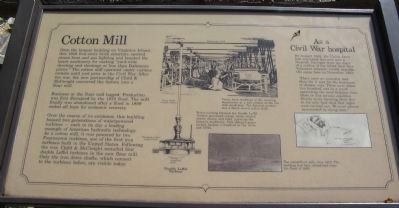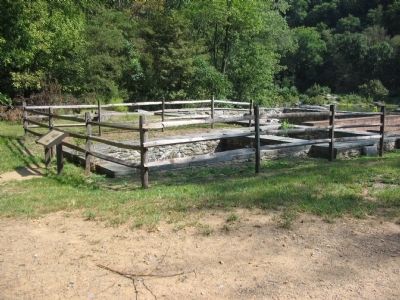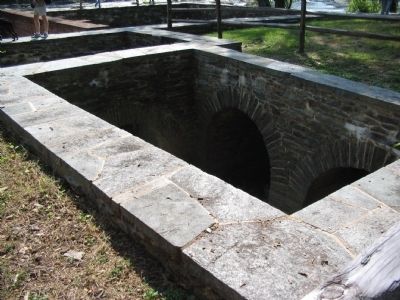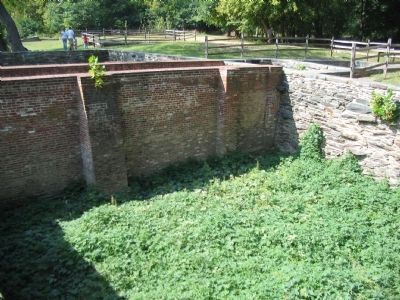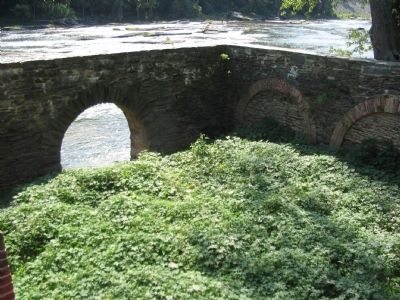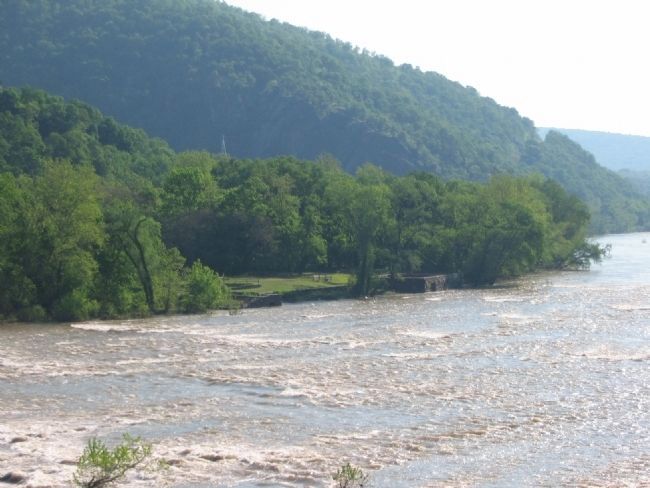Harpers Ferry in Jefferson County, West Virginia — The American South (Appalachia)
Cotton Mill
Business at the flour mill lagged. Production was first disrupted by the 1870 flood. The mill finally was abandoned after a flood in 1889 ended all hope for economic recover.
Over the course of its existence, this building housed two generations of waterpowered turbines - each in its day a leading example of American hydraulic technology. As a cotton mill, it was powered by two Fourneyron turbines, one of the first iron turbines built in the United States. Following the war, Child & McCreight installed four double Leffel turbines in the new flour mill. Only the iron drive shafts, which connect to the turbines below, are visible today.
Water running through the Double Leffel Turbine generated energy which rotated shafts, drums, and belts powering the factory's machinery. This efficient power turbine became a standard in the 1870s and 1880s.
As a Civil War Hospital
By August 1862, the Union Army had converted this mill into a hospital. Excerpts from the diary of a soldier of the 123rd New York Volunteer Infantry vividly describe the scene here in November 1862:
"There were no wounded men there for it was for the treatment of disease only. There were about two hundred cots in a ward...separating the most helpless from those in less serious condition. Nearly every morning from five to ten who had died that night were carried out. We were almost surrounded by dying men."
Topics. This historical marker is listed in these topic lists: Industry & Commerce • War, US Civil. A significant historical month for this entry is November 1862.
Location. 39° 19.259′ N, 77° 44.054′ W. Marker is in Harpers Ferry, West Virginia, in Jefferson County. Marker can be reached from Shenandoah Street (Business U.S. 340), on the right when traveling east. Located on Virginius Island in Harpers Ferry National Historic Site. Touch for map. Marker is in this post office area: Harpers Ferry WV 25425, United States of America. Touch for directions.
Other nearby markers. At least 8 other markers are within walking distance of this marker. Water Tunnels (within shouting distance of this marker); Shenandoah Canal (about 400 feet away, measured in a direct line); Jefferson Rock (about 600 feet away); a different marker also named Jefferson Rock (about 600 feet away); Jonathan Child House (about 600 feet away); River Wall (about 600 feet away); Butcher Shop and Boarding House (about 700 feet away); Island Mills (about 800 feet away). Touch for a list and map of all markers in Harpers Ferry.
More about this marker. In the center is a diagram showing a Double Leffel Turbine and the mill's production rooms. Power loom machines in the weaving department at the mill similar to the one that stood here. The finished product was a finely woven cotton cloth. In the lower center is a faded photo showing The cotton/flour mill, circa 1904. The building had been abandoned since the flood of 1889.
In the lower right is a drawing of a soldier in a Civil War hospital.
Also see . . . Virginius Island Waterpowered Mill Complex. Historic American Building Survey. (Submitted on May 10, 2009, by Craig Swain of Leesburg, Virginia.)
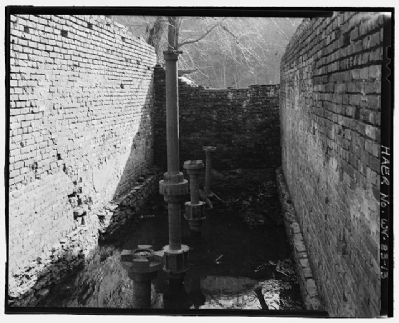
Photographed By Craig Swain
7. Turbine Pit
The turbine shafts extend out of the pit in this photo from Historic American Building Survey files.
Click for more information.
Click for more information.
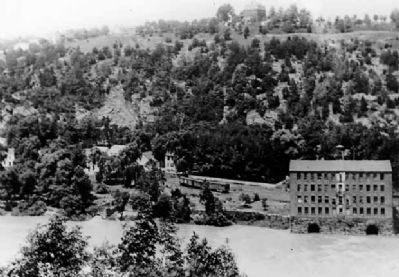
Photographed By Craig Swain
8. 1900 era View of the Mill
The mill building stood until the flood of 1936.
(Image Source: Historic Photo Collection, Harpers Ferry NHP, Catalog number hf-0062.
Click for more information.
(Image Source: Historic Photo Collection, Harpers Ferry NHP, Catalog number hf-0062.
Click for more information.
Credits. This page was last revised on June 16, 2016. It was originally submitted on May 10, 2009, by Craig Swain of Leesburg, Virginia. This page has been viewed 1,449 times since then and 59 times this year. Photos: 1, 2, 3, 4, 5, 6, 7, 8. submitted on May 10, 2009, by Craig Swain of Leesburg, Virginia.
